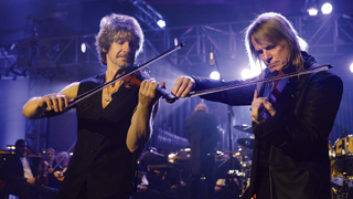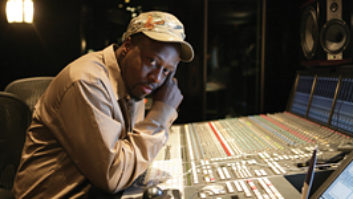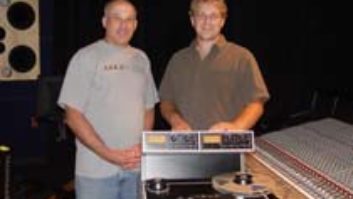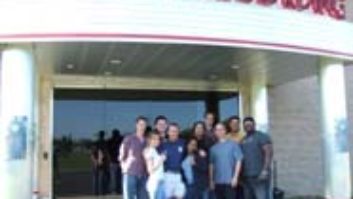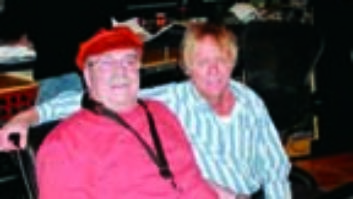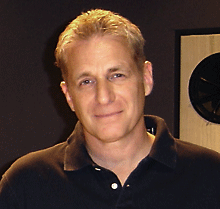
Before producer Jeff Glixman had even set foot on the other side of the glass, it seemed his fate was sealed. During Glixman’s performing days — he played in a number of bands, including the Kansas precursor, Cocky Fox — his manager predicted that he would eventually step into the producer’s chair. His first production was the 1974 Kansas release Song for America (followed by three more releases by that band in the ’70s), and in the 30-plus years since, Glixman has worked with such artists as Eric Clapton, Gary Moore, Yngwie Malmsteen, the Allman Brothers, the Georgia Satellites, Black Sabbath and Orange Sky. Most recently, he used his mixing talents on 5.1 surround projects for the Allman Brothers’ legendary Eat a Peach and At Fillmore East, Ludacris’ Chicken N Beer, Marvin Gaye’s Let’s Get It On and Bob Marley & The Wailers’ Live at Leeds, the second disc in the deluxe-edition reissue of Burnin’.
We caught up with Glixman at StarCity Recording Company, the recording studio he owns and operates in Bethlehem, Pa.
What are you up to these days?
I’ve recently completed a project with a new group out of Harrisburg. Pennsylvania, called Bridges and a Bottle. [The album is called Trojan Horse.] I’m in the process of working with Nathan Lee Jackson, who is signed to our production company. I’m also in the preliminary stages of working with Tyrone Vaughan, who is the son of Jimmie Vaughan of the Fabulous Thunderbirds and nephew of Stevie Ray Vaughan.
Your credit list includes some fairly well-known names. How do you like working with those younger acts?
Well, I’ve always enjoyed that. Even the big successes I’ve had, whether it was with Kansas, the Georgia Satellites or Gary Moore, I started in development with them when they were young bands.
What I enjoy the most is the artist development, the formative stages and working on the songs. Also, I like that “We don’t have anything to lose because we don’t have anything yet” attitude that comes early in careers. One of the pitfalls that can happen is once you’ve been successful, sometimes it’s hard to be quite as adventurous because you don’t want to lose the success that you’ve had. So artists tend to become a little more concerned about that rather than wanting to say everything artistically on a record.
When you were starting out as a musician, did you have an ear toward what was happening in production?
I didn’t. We were pretty remote, and there was no glass to be on the other side of. [Laughs] Oddly enough, one of our earlier managers was making up quotes for a bio, and in my quote he put down that ultimately one day I would like to be a producer. I was always heavily involved in arrangements and the overall sound of the band. I would say to the guys, “Wait a minute, what are you playing here? That doesn’t fit. Everyone is playing in the same octave. Let’s stretch this out and leave a little space for the vocal.”
Has being a studio owner helped you?
Opening a studio had nothing to do with being a record producer. My heritage is that I went from playing in groups to producing. I have never worked in a studio, so to speak, and I’ve never really opened a studio to have production. I’ve been involved in a partnership fashion in two studios: this studio, for which we formed this partnership about 10 months ago, and Axis Sound Studios in Atlanta. When I was at the studio in Atlanta, I did very little of my production there. I did most of my work in England and Los Angeles because Axis was a one-room facility and it was booked quite a bit. Also, I was working a lot with English artists. I don’t know that opening a studio would give anybody the ability to produce. To me, that is like saying, “I have a soundstage — I guess I’ll just direct a movie.” [Laughs]
Although we are called record producers, we are really directors. If we make it an aural event, just like a movie is a visual event, the job description is really the director of the movie, not the producer of the movie. I suppose the record company or whoever is funding the project is, in essence, the “producer,” but for my productions, I take on that role of director of the movie. I’ll start with the script, which in this case is the songs. If we are fortunate, we’ll say, “Hey, it’s perfect, leave it alone.” If it is terrible, we have to throw it out and find new scripts or new songs. Typically, we just have to rearrange the songs. At that point, I’ve got my aural look for this movie, which may be a bombastic, large thing or it may be just a very close, intimate album. So you’re always working toward that goal, and just as a director would work with his cameraman and his editor, I’ll work with my engineers to technically handle this task, and I’ll work with the musicians and singers, and work on their performance.
You’ve also mixed a handful of SACD releases. It seems like when you were recording a band like Kansas, and specifically the song “Dust in the Wind,” there was some thought about spreading the sound across a spectrum by using mic placement. I know that surround wasn’t happening back then, but did you have an ear toward something other than stereo?
It’s really interesting that you say that because when I started, I was very nontechnical. It is true in a way that you’re just really feeling the music, but I always visualized it. I didn’t know there was such a thing as surround sound and that 5.1 was going to come, but I always thought in that dimension. When I mix, I see things as triangles. If you make a left point, a right point and then put a third point behind your head, I see that triangle for depth.

Glixman in the “Dust in the Wind” producing days
Are there certain bands that lend themselves better to 5.1 mixing?
This may sound a little strange, but all the projects I’ve done each lend themselves [to 5.1] in different ways. If you have very little information to work with, it becomes difficult. Or if there is sloppiness or things that need to be tucked in, it is very hard to do in a surround sound domain. The best 5.1 project that I’ve done is the performance DVD for Orange Sky. I knew it was going to be surround going into recording. I was able to really mike up the venue itself, and that just worked tremendously well. I used this 1,300-seat club for all its ambience, and we did a careful mix within the room. I think all the projects that I’ve worked on have enjoyed great benefits from being in 5.1, from the Kansas stuff to the Allman Brothers. I think the one that set up the best was the Ludacris Chicken N Beer record.
Do you think hip hop is especially good for that treatment or was it just that record?
I can see where a lot of hip hop would [work] because there is a lot of call and answer and doubling up of individual vocal lines. It just sounds great coming from all over the spectrum. I was actually very surprised that we didn’t see a lot of hip hop coming out in 5.1 because I listened to a lot of other things that would set up very well for it. Some of the tracks were very sparse, some of them had 60 to 70 tracks on them, but they all worked very well in the domain.
A lot of stuff gets crowded. On Ludacris’ record, there would be three or four samples at the same time on the kick drum and a bunch of voices and all kinds of things crammed into stereo. It’s all there and you can hear it, but when you break it into 5.1, it becomes really apparent. We went in and did some cleanup on the samples, time-aligned those very closely, and we were able to place them differently in the spectrum.
I hope this question doesn’t put you in a delicate place, but does Marvin Gaye work in surround? Does Bob Marley?
Marvin works in surround. That was a tough one, and the reason was that there were no particularly good sounds when we brought up the instruments. Everything was bleeding through and onto everything else. It was [recorded] in one room, so the drums are showing up on the string tracks and the bass guitar was coming from there. It was impossible to derive a [low-frequency] channel because there was a big rumble on everything.
That said, part of what made it so good in surround was that we were able to clean up some of that stuff. When I approached that mix, I wanted to clean it up and spread it out, but it didn’t work at all. I really had to go back and remember that when Cal Harris worked on it, it made sense once. I had to find that spot with all the faders up, because so much of that album is using the bleed and the spill that was coming from other instruments on the mics to get the sound that there is no way you’ll really create these spaces in 5.1 without it sounding pretty disjointed. You can’t move stuff too far away and do too much because [if you were] going to move the piano, you’re moving the piano and the drums.

Glixman (far right, foreground) with StarCity engineer Zak Rizvi (left, foreground) with Bridges and a Bottle
On the other hand, even though the Bob Marley [tracks were] very minimalist, it worked incredibly well. The recordings [for Burnin‘ and Live at Leeds] were beautiful, and it was just one of those things where there was no problem with it at all. The Allman Brothers’ At Fillmore East really works well, too. Part of that is because I tried to listen carefully to the audience tracks and kind of emulate the size of that room. One thing I did end up doing was putting an actual time delay in the audience mics and shifting the perspective a bit to make the hall sound the right size. I have no idea where the audience mics were and I don’t know if they were close to the stage or far away, but when I moved them back in time, it really came to life and started settling in. The phase relationship picked up and the low end got solid. It was very difficult from the standpoint that there were two drummers and the total tracks [recorded] on drums was four. So you had bass drum, drums left and bass drum and drums right.
What makes that record the best, though, was that there were some open stage mics that were open through every other previous version of this project. We went in, cleaned those up and really did a lot of cleanup around Gregg Allman’s vocals, where a lot of guitar was coming through. When we got rid of [the bleed in Allman’s vocal track], it became really rich-sounding.
So many live albums are augmented later on with studio tracks, tuned up or cleaned up. Did you think of doing any of that on these releases?
I did think about it. These are old tapes and there was one spot [on At Fillmore East] where there was a problem with the tape. There was a spot where there was something like a crease in the analog tape or something. So I did copy and paste a quick moment that happened many times in the song. I corrected that because it felt appropriate to me to restore it to what it was. If Dickey hit a flat note, he hit a flat note and that is how it goes. On the other hand, on “Mountain Jam,” which is on Eat a Peach, when they recorded it live, they used two analog 16-track [machines] that were running at ever so slightly different speeds. When the edits had been made, there was a slight pitch and tempo shift. I went ahead and corrected that. Oddly enough, to do that correction, I did it on analog machines where I made them match, transferred that to digital and then put it together. I felt that was an appropriate restoration.
What did you use to mix these projects?
Most of these projects were mixed on an SSL XL 9000 K. Although I think it’s an excellent-sounding console, I rely pretty heavily on external processing. As far as EQ goes, I have some pieces that I prefer — Amek 9098, Neve modules and Tube-Tech’s 5-band modules. I like compressors like LA-2As, 1176s, Neve 33609 and the Distressors. Of course, the SSL EQ works well for certain things. I did all the panning within Pro Tools because the analog tapes were too fragile and they couldn’t withstand the passes. So I make a high-res pass from analog to Pro Tools as a flat master. Then I take those tracks and come back through the SSL. At that point, I build my mix, but I return it into Pro Tools so that I can print it. I use the panning within Pro Tools because it’s easy to automate the panning and make changes.
While working with these newer artists now, are you thinking about surround sound?
Constantly. I like to record rooms with people and instruments in them so I usually have plenty of that information around. Surround sound has really taken off in the broadcast world with HDTV, and XM Radio and SIRIUS will be broadcasting in surround. The projects that I’m working on now look like they will be stereo projects at this point, but I would certainly love to mix them in surround. You never know — something might come up.
David John Farinella is a San Francisco — based writer.
